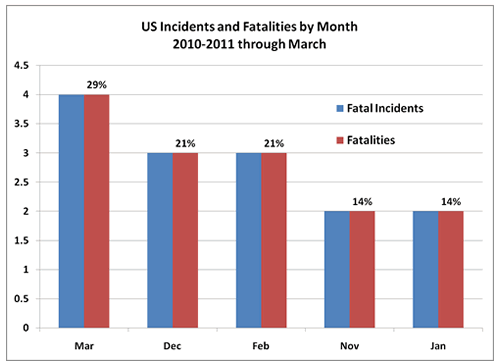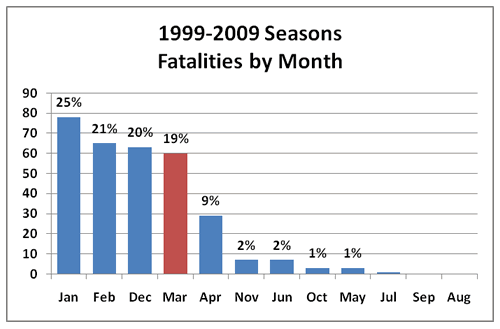April 02, 2011: March Incidents this Season
Comments on this post are disabled because it is an old post and the spam bots have now discovered it. If you would like to comment or to arrange a related guest post contact the avalanche center at snow@csac.org
After the previous entry about March ranking pretty high in fatalities how did this season stack up?
Well, first of all there have only been 14 fatal incidents which is well below average. (This does not count a cornice collapse in WA because it's not clear what role the avalanche played, if any, in the fatality. But this would make it 15.) The average over the previous 10 season is 31 or 32. And second, each of these had only one fatality. So in the US we've had fewer fatalities than usual and no multiple fatality incidents at all. A good winter so far!
Of the 14 fatal incidents 4 were March, or 29%. This makes March the month with the greatest number of fatal incidents and fatalities this season. Keep in mind, though, that the season total is bound to increase some which will lower the percentages shown.

So how does this compare to a historical average? For all fatalities in the previous ten years March ranks fourth, after the preceding three months. Although it is very close to February and March and the difference between the three may be statistically insignificant. The percentage of fatalities is 19%. The number of incidents were not counted for this time period for this blog entry.

While this is interesting to review we can't draw too many conclusions from it. The sample sizes are clearly quite different (316 fatalities vs 14). The ten year graph does not distinguish between the different seasons, and there can be wide variations. This seasons graph does not reflect the entire season which will almost certainly increase the numbers, making the percentage for March lower. Although it's unlikely to lose it's top rank.
The distribution for the 1950-2009 seasons differs from that for the last ten. The last ten seasons are probably more representative of incidents today. Going back too far incorporates seasons when backcountry recreation was not as large a factor as it is today. Snowboards didn't exist and snowmobiles rarely got into avalanche terrain.
Looking ahead, there is a marked drop in April. This may not be true every season but on the whole there are less fatalities. Of course this may reflect the diminishing number of people in the backcountry as they transition to biking and boating as well as seasonal snowpack factors.
After the previous entry about March ranking pretty high in fatalities how did this season stack up?
Well, first of all there have only been 14 fatal incidents which is well below average. (This does not count a cornice collapse in WA because it's not clear what role the avalanche played, if any, in the fatality. But this would make it 15.) The average over the previous 10 season is 31 or 32. And second, each of these had only one fatality. So in the US we've had fewer fatalities than usual and no multiple fatality incidents at all. A good winter so far!
Of the 14 fatal incidents 4 were March, or 29%. This makes March the month with the greatest number of fatal incidents and fatalities this season. Keep in mind, though, that the season total is bound to increase some which will lower the percentages shown.

So how does this compare to a historical average? For all fatalities in the previous ten years March ranks fourth, after the preceding three months. Although it is very close to February and March and the difference between the three may be statistically insignificant. The percentage of fatalities is 19%. The number of incidents were not counted for this time period for this blog entry.

While this is interesting to review we can't draw too many conclusions from it. The sample sizes are clearly quite different (316 fatalities vs 14). The ten year graph does not distinguish between the different seasons, and there can be wide variations. This seasons graph does not reflect the entire season which will almost certainly increase the numbers, making the percentage for March lower. Although it's unlikely to lose it's top rank.
The distribution for the 1950-2009 seasons differs from that for the last ten. The last ten seasons are probably more representative of incidents today. Going back too far incorporates seasons when backcountry recreation was not as large a factor as it is today. Snowboards didn't exist and snowmobiles rarely got into avalanche terrain.
Looking ahead, there is a marked drop in April. This may not be true every season but on the whole there are less fatalities. Of course this may reflect the diminishing number of people in the backcountry as they transition to biking and boating as well as seasonal snowpack factors.

